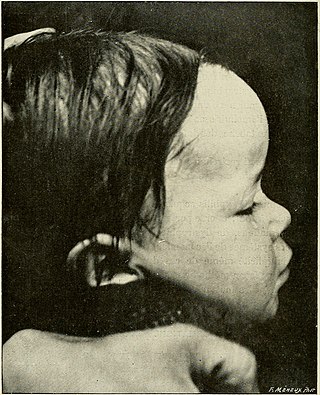
Macrocephaly is a condition in which circumference of the human head is abnormally large. It may be pathological or harmless, and can be a familial genetic characteristic. People diagnosed with macrocephaly will receive further medical tests to determine whether the syndrome is accompanied by particular disorders. Those with benign or familial macrocephaly are considered to have megalencephaly.

Brachycephaly is the shape of a skull shorter than average in its species. It is perceived as a cosmetically desirable trait in some domesticated dog and cat breeds, notably the pug and Persian, and can be normal or abnormal in other animal species.

Turricephaly is a type of cephalic disorder where the head appears tall with a small length and width. It is due to premature closure of the coronal suture plus any other suture, like the lambdoid, or it may be used to describe the premature fusion of all sutures. It should be differentiated from Crouzon syndrome. Oxycephaly is a form of turricephaly where the head is cone-shaped, and is the most severe of the craniosynostoses.

A unibrow is a single eyebrow created when the two eyebrows meet in the middle above the bridge of the nose. The hair above the bridge of the nose is of the same color and thickness as the eyebrows, such that they converge to form one uninterrupted line of hair.

Arthrogryposis (AMC) describes congenital joint contracture in two or more areas of the body. It derives its name from Greek, literally meaning 'curving of joints'.

X-linked recessive inheritance is a mode of inheritance in which a mutation in a gene on the X chromosome causes the phenotype to be always expressed in males and in females who are homozygous for the gene mutation, see zygosity. Females with one copy of the mutated gene are carriers.
Hereditary inclusion body myopathies (HIBM) are a group of rare genetic disorders which have different symptoms. Generally, they are neuromuscular disorders characterized by muscle weakness developing in young adults. Hereditary inclusion body myopathies comprise both autosomal recessive and autosomal dominant muscle disorders that have a variable expression (phenotype) in individuals, but all share similar structural features in the muscles.

Walker–Warburg syndrome (WWS), also called Warburg syndrome, Chemke syndrome, HARD syndrome, Pagon syndrome, cerebroocular dysgenesis (COD) or cerebroocular dysplasia-muscular dystrophy syndrome (COD-MD), is a rare form of autosomal recessive congenital muscular dystrophy. It is associated with brain and eye abnormalities. This condition has a worldwide distribution. Walker-Warburg syndrome is estimated to affect 1 in 60,500 newborns worldwide.
Congenital myopathy is a very broad term for any muscle disorder present at birth. This defect primarily affects skeletal muscle fibres and causes muscular weakness and/or hypotonia. Congenital myopathies account for one of the top neuromuscular disorders in the world today, comprising approximately 6 in 100,000 live births every year. As a whole, congenital myopathies can be broadly classified as follows:

Bethlem myopathy is predominantly an autosomal dominant myopathy, classified as a congenital form of limb-girdle muscular dystrophy. There are two types of Bethlem myopathy, based on which type of collagen is affected.
Zamzam–Sheriff–Phillips syndrome is a rare autosomal recessive congenital disorder. It is characterized by aniridia, ectopia lentis, abnormal upper incisors and intellectual disability. Not a lot of research has been undertaken of this particular disease so thus far there is no known gene that affects this condition. However it has been hypothesised that the symptoms described are found at a particular gene, though intellectual disability is believed to be due to a different genetic cause.

Marden–Walker syndrome (MWS) is a rare autosomal recessive congenital disorder. It is characterized by blepharophimosis, microcephaly, micrognathia, multiple joint contractures, arachnodactyly, camptodactyly, kyphoscoliosis and delayed motor development and is often associated with cystic dysplastic kidneys, dextrocardia, Dandy–Walker malformation and agenesis of corpus callosum.

Marinesco–Sjögren syndrome (MSS), sometimes spelled Marinescu–Sjögren syndrome, is a rare autosomal recessive disorder.

Ullrich congenital muscular dystrophy (UCMD) is a form of congenital muscular dystrophy. There are two forms: UCMD1 and UCMD2.

Schwartz–Jampel syndrome is a rare genetic disease caused by a mutation in the perlecan gene (HSPG2) which causes osteochondrodysplasia associated with myotonia. Most people with Schwartz–Jampel syndrome have a nearly normal life expectancy.
Blepharophimosis intellectual disability syndromes are a group of rare genetic disorders which are characterized by blepharophimosis, ptosis, and intellectual disabilities. These disorders usually follow either autosomal recessive, autosomal dominant, x-linked recessive, or mitochondrial inheritance patterns.

High anterior hairline is a condition in which the frontal hairline which defines the top and sides of the forehead is unusually high. This can mean that either the distance between the trichion (hairline) and glabella is more than 2 SD above the mean, or that this distance is apparently (subjectively) increased.
Cardiocranial syndrome, Pfeiffer type is a rare multiple disorder syndrome characterized by congenital heart defects, sagittal craniosynostosis, and severe developmental delay. The condition has been reported in less than 10 patients worldwide.











